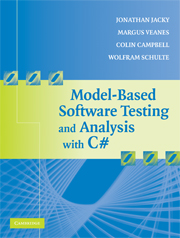Preface
Published online by Cambridge University Press: 02 March 2010
Summary
This book teaches new methods for specifying, analyzing, and testing software. They are examples of model-based analysis and model-based testing, which use a model that describes how the program is supposed to behave. The methods provide novel solutions to the problems of expressing and analyzing specifications and designs, generating test cases, and checking the results of test runs. The methods increase the automation in each of these activities, so they can be more timely, more thorough, and (we expect) more effective. The methods integrate concepts that have been investigated in academic and industrial research laboratories for many years and apply them on an industrial scale to commercial software development. Particular attention has been devoted to making these methods acceptable to working software developers. They are based on a familiar programming language, are supported by a well-engineered technology, and have a gentle learning curve.
These methods provide more test automation than do most currently popular testing tools, which only automate test execution and reporting, but still require the tester to code every test case and also to code an oracle to check the results of every test case. Moreover, our methods can sometimes achieve better coverage in less testing time than do hand-coded tests.
Testing (i.e., executing code) is not the only assurance method. Some software failures are caused by deep errors that originate in specifications or designs. Model programs can represent specifications and designs, and our methods can expose problems in them. They can help you visualize aspects of system behavior.
- Type
- Chapter
- Information
- Model-Based Software Testing and Analysis with C# , pp. xi - xivPublisher: Cambridge University PressPrint publication year: 2007

